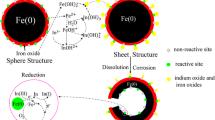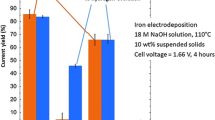Abstract
Iron, chromium, nickel, and manganese released from gas-atomized AISI 316L stainless steel powders (sized <45 and <4 μm) were investigated in artificial lysosomal fluid (ALF, pH 4.5) and in solutions of its individual inorganic and organic components to determine its most aggressive component, elucidate synergistic effects, and assess release mechanisms, in dependence of surface changes using atomic absorption spectroscopy, Raman, XPS, and voltammetry. Complexation is the main reason for metal release from 316L particles immersed in ALF. Iron was mainly released, while manganese was preferentially released as a consequence of the reduction of manganese oxide on the surface. These processes resulted in highly complexing media in a partial oxidation of trivalent chromium to hexavalent chromium on the surface. The extent of metal release was partially controlled by surface properties (e.g., availability of elements on the surface and structure of the outermost surface) and partially by the complexation capacity of the different metals with the complexing agents of the different media. In general, compared to the coarse powder (<45 μm), the fine (<4 μm) powder displayed significantly higher released amounts of metals per surface area, increased with increased solution complexation capacity, while less amounts of metals were released into non-complexing solutions. Due to the ferritic structure of lower solubility for nickel of the fine powder, more nickel was released into all solutions compared with the coarser powder.
Access this article
We’re sorry, something doesn't seem to be working properly.
Please try refreshing the page. If that doesn't work, please contact support so we can address the problem.







Similar content being viewed by others
References
Amirbahman A, Sigg L, von Gunten U (1997) Reductive dissolution of Fe(III) (hydr)oxides by cysteine: kinetics and mechanism. J Colloid Interface Sci 194:194–206
Ballesteros MC, Rueda EH, Blesa MA (1998) The influence of iron (II) and (III) on the kinetics of goethite dissolution by EDTA. J Colloid Interface Sci 201:13–19
Benali O, Abdelmoula M, Refait P, Génin J-MR (2002) The behaviour of phosphate ions as corrosion inhibitor for Fe(II)-Fe(III) hydroxycarbonate green rust. Hyperfine Interact 139(140):223–230
Blair M (2005) Corrosion of cast stainless steels, corrosion: materials. In: Cramer SD, Covino BS Jr. ASM Handbook, vol 13B. ASM International, Materials Park, Ohio, pp 78–87
Brooks AR, Clayton CR, Doss K, Lu YC (1986) On the role of Cr in the passivity of stainless steel. J Electrochem Soc 133(12):2459–2464
Carbonaro RF, Gray BN, Whitehead CF, Stone AT (2008) Carboxylate-containing chelating agent interactions with amorphous chromium hydroxide: adsorption and dissolution. Geochim Cosmochim Ac 72(13):3241–3257
Cieslik M, Reczynski W, Janus AM, Engvall K, Socha RP, Kotarba A (2009) Metal release and formation of surface precipitate at stainless steel grade 316 and Hanks solution interface—inflammatory response and surface finishing effects. Corros Sci 51(5):1157–1162
de Faria DLA, Venâncio Silva S, de Oliveira MT (1997) Raman microspectroscopy of some iron oxides and oxyhydroxides. J Raman Spectrosc 28(11):873
Dhinsa NK, Griffiths DR, Brooks PN (2008) Stainless steel powder (Grade 316L): twenty-eight day repeated dose exposure inhalation (nose only) toxicity study in the rat, SPL project number: 2476/0001. SafePharm Laboratories
Dos Santos Afonso M, Morando PJ, Blesa MA, Banwart S, Stumm W (1990) The reductive dissolution of iron oxides by ascorbate: the role of carboxylate anions in accelerating reductive dissolution. J Colloid Interface Sci 138:74–82
EU (2007) REACH in brief. European Commission Environment Directorate General, http://.ec.europa.eu/environment/chemicals/reach/pdf/2007_02_reach_in_brief.pdf
Farrow RL, Benner RE, Nagelberg AS, Mattern PL (1980) Characterization of surface oxides by Raman spectroscopy. Thin Solid Films 73(2):353
Femenia M, Pan J, Leygraf C (2004) Characterization of ferrite-austenite boundary region of duplex stainless steels by SAES. J Electrochem Soc 151(11):B581–B585
Gaskell DR (1973) Introduction to metallurgical thermodynamics. McGraw-Hill, New York
Hedberg Y, Gustafsson J, Karlsson HL, Möller L, Odnevall Wallinder I (2010a) Bioaccessibility, bioavailability and toxicity of commercially relevant iron- and chromium-based particles: in vitro studies with an inhalation perspective. Part Fibre Toxicol 7:23
Hedberg Y, Midander K, Odnevall Wallinder I (2010b) Particles, sweat, and tears: a comparative study on bioaccessibility of ferrochromium alloy and stainless steel particles, the pure metals and their metal oxides, in simulated skin and eye contact. Integr Environ Assess Manag 6(3):456–468
Hedberg Y, Karlsson O, Szakalos P, Odnevall Wallinder I (2011) Ultrafine 316L stainless steel particles with frozen-in magnetic structures characterized by means of electron backscattered diffraction. Mater Lett 65(14):2089–2092
Herting G (2008) Bioaccessibility of stainless steels—importance of bulk and surface features. Doctoral Thesis, Royal Institute of Technology (KTH), Stockholm
Herting G, Odnevall Wallinder I, Leygraf C (2005) A comparison of release rates of Cr, Ni, and Fe from stainless steel alloys and the pure metals exposed to simulated rain events. J Electrochem Soc 152(1):B23–B29
Herting G, Odnevall Wallinder I, Leygraf C (2006) Factors that influence the release of metals from stainless steels exposed to physiological media. Corros Sci 48(8):2120–2132
Herting G, Odnevall Wallinder I, Leygraf C (2008a) Corrosion-induced release of chromium and iron from ferritic stainless steel grade AISI 430 in simulated food contact. J Food Eng 87(2):291–300
Herting G, Odnevall Wallinder I, Leygraf C (2008b) Corrosion-induced release of the main alloying constituents of manganese–chromium stainless steels in different media. J Environ Monitor 10:1084–1091
Huvinen M, Oksanen L, Kalliomäki K, Kalliomäki P-L, Moilanen M (1997) Estimation of individual dust exposure by magnetopneumography in stainless steel production. Sci Total Environ 199(1–2):133–139
Huvinen M, Makitie A, Jarventaus H, Wolff H, Stjernvall T, Hovi A, Hirvonen A, Ranta R, Nurminen M, Norppa H (2002) Nasal cell micronuclei, cytology and clinical symptoms in stainless steel production workers exposed to chromium. Mutagenesis 17(5):425–429
Isaacs HS, Virtanen S, Ryan MP, Schmuki P, Oblonsky LJ (2002) Incorporation of Cr in the passive film on Fe from chromate solutions. Electrochim Acta 47(19):3127–3130
Kocijan A, Milošev I, Pihlar B (2003) The influence of complexing agent and proteins on the corrosion of stainless steels and their metal components. J Mater Sci Mater Med 14(1):69–77
Lanone S, Rogerieux F, Geys J, Dupont A, Maillot-Marechal E, Boczkowski J, Lacroix G, Hoet P (2009) Comparative toxicity of 24 manufactured nanoparticles in human alveolar epithelial and macrophage cell lines. Part Fibre Toxicol 6(1):14
Lindell D, Pettersson R (2010) Pickling of process-oxidised austenitic stainless steels in HNO3-HF mixed acid. Steel Res Int 81(7):542–551
Linhardt P (2010) Twenty years of experience with corrosion failures caused by manganese oxidizing microorganisms. Mater Corros 61:1034–1039
Lutz HD, Müller B, Steiner HJ (1991) Lattice vibration spectra. LIX. Single crystal infrared and Raman studies of spinel type oxides. J Solid State Chem 90(1):54–60
Marcus P, Oudar J (eds) (1995) Corrosion mechanisms in theory and practice. Marcel Dekker, Inc., Paris
Midander K, Pan J, Leygraf C (2006) Elaboration of a test method for the study of metal release from stainless steel particles in artificial biological media. Corros Sci 48(9):2855–2866
Midander K, Pan J, Odnevall Wallinder I, Leygraf C (2007) Metal release from stainless steel particles in vitro—influence of particle size. J Environ Monitor 9:74–81
Midander K, de Frutos A, Hedberg Y, Darrie G, Odnevall Wallinder I (2010) Bioaccessibility studies of ferro-chromium alloy particles for a simulated inhalation scenario: a comparative study with the pure metals and stainless steel. Integr Environ Asses Manag 6(3):441–455
Milošev I (2002) Effect of complexing agents on the electrochemical behaviour of orthopaedic stainless steel in physiological solution. J Appl Electrochem 32(3):311–320
Milosev I, Strehblow H–H (2000) The behavior of stainless steels in physiological solution containing complexing agent studied by X-ray photoelectron spectroscopy. J Biomed Mater Res 52(2):404–412
Moulin JJ, Wild P, Mantout B, Fournier-Betz M, Mur JM, Smagghe G (1993) Mortality from lung cancer and cardiovascular diseases among stainless-steel producing workers. Cancer Cause Control 4(2):75–81
Moulin JJ, Clavel T, Roy D, Dananché B, Marquis N, Févotte J, Fontana JM (2000) Risk of lung cancer in workers producing stainless steel and metallic alloys. Int Arch Occup Environ Health 73(3):171–180
Nakayama E, Kuwamoto T, Tsurubo S, Fujinaga T (1981) Chemical speciation of chromium in sea water: part 2. Effects of manganese oxides and reducible organic materials on the redox processes of chromium. Anal Chim Acta 130(2):401–404
Nurminen M (2005) Overview of the human carcinogenicity risk assessment of metallic chromium and trivalent chromium. Internet J Epidemiol 2(1)
Oblonsky LJ, Devine TM (1995) A surface enhanced Raman spectroscopic study of the passive films formed in borate buffer on iron, nickel, chromium and stainless steel. Corros Sci 37(1):17–41
Okazaki Y, Gotoh E (2005) Comparison of metal release from various metallic biomaterials in vitro. Biomaterials 26(1):11–21
Olsson C-OA, Landolt D (2003) Passive films on stainless steels—chemistry, structure and growth. Electrochim Acta 48:1093–1104
Ramsey JD, McCreery RL (2004) Raman microscopy of chromate interactions with corroding aluminum alloy 2024-T3. Corros Sci 46(7):1729–1739
Richard FC, Bourg ACM (1991) Aqueous geochemistry of chromium: a review. Water Res 25(7):807–816
Santonen T, Stockmann-Juvala H, Odnevall Wallinder I, Darrie G, Zitting A (2010) Use of read-across in the health risk assessment of ferro-chromium alloys under REACH. In: The Twelfth International Ferro Alloy Congress (INFACON XII), Helsinki (FI), 6–9 June 2010
Schwertmann U (1991) Solubility and dissolution of iron oxides. Plant Soil 130:1–25
Slemnik M, Milošev I (2006) An impedance study of two types of stainless steel in Ringer physiological solution containing complexing agents. J Mater Sci Mater Med 17(10):911–918
Sousa SR, Barbosa MA (1991) Electrochemistry of AISI 316L stainless steel in calcium phosphate and protein solutions. J Mater Sci Mater Med 2(1):19–26
Stopford W, Turner J, Cappellini D, Brocka T (2003) Bioaccessibility testing of cobalt compounds. J Environ Monitor 5:675–680
Stumm W, Morgan JJ (1996) Aquatic chemistry, 3rd edn. Wiley, New York
Sudesh TL, Wijesinghe L, Blackwood DJ (2006) Characterisation of passive films on 300 series stainless steels. Appl Surf Sci 253(2):1006–1009
Zhang Y, Kallay N, Matijevic E (1985) Interaction of metal hydrous oxides with chelating agents. 7. Hematite-oxalic acid and -citric acid systems. Langmuir 1:201–206
Acknowledgments
Cusanuswerk, Germany, is highly acknowledged for the financial support of Yolanda Hedberg. The authors are members of the Stockholm Particle Group, an operative network between three universities in Stockholm: Karolinska Institutet, Royal Institute of Technology, and Stockholm University, supported by the Swedish Research Council. Instrumental grants from Knut and Alice Wallenberg foundation (XPS), Jernkontoret and Carl Trygger Foundation (Voltammetric equipment) are acknowledged. The grant from Nils and Dorthi Troëdsson Foundation for the combined confocal Raman AFM equipment is gratefully acknowledged. Ashkan Reza Gholi is highly acknowledged for parts of the exposures. Prof. Paul Linhardt, Vienna University of Technology, Austria, is highly acknowledged for his scientific support.
Author information
Authors and Affiliations
Corresponding author
Rights and permissions
About this article
Cite this article
Hedberg, Y., Hedberg, J., Liu, Y. et al. Complexation- and ligand-induced metal release from 316L particles: importance of particle size and crystallographic structure. Biometals 24, 1099–1114 (2011). https://doi.org/10.1007/s10534-011-9469-7
Received:
Accepted:
Published:
Issue Date:
DOI: https://doi.org/10.1007/s10534-011-9469-7




